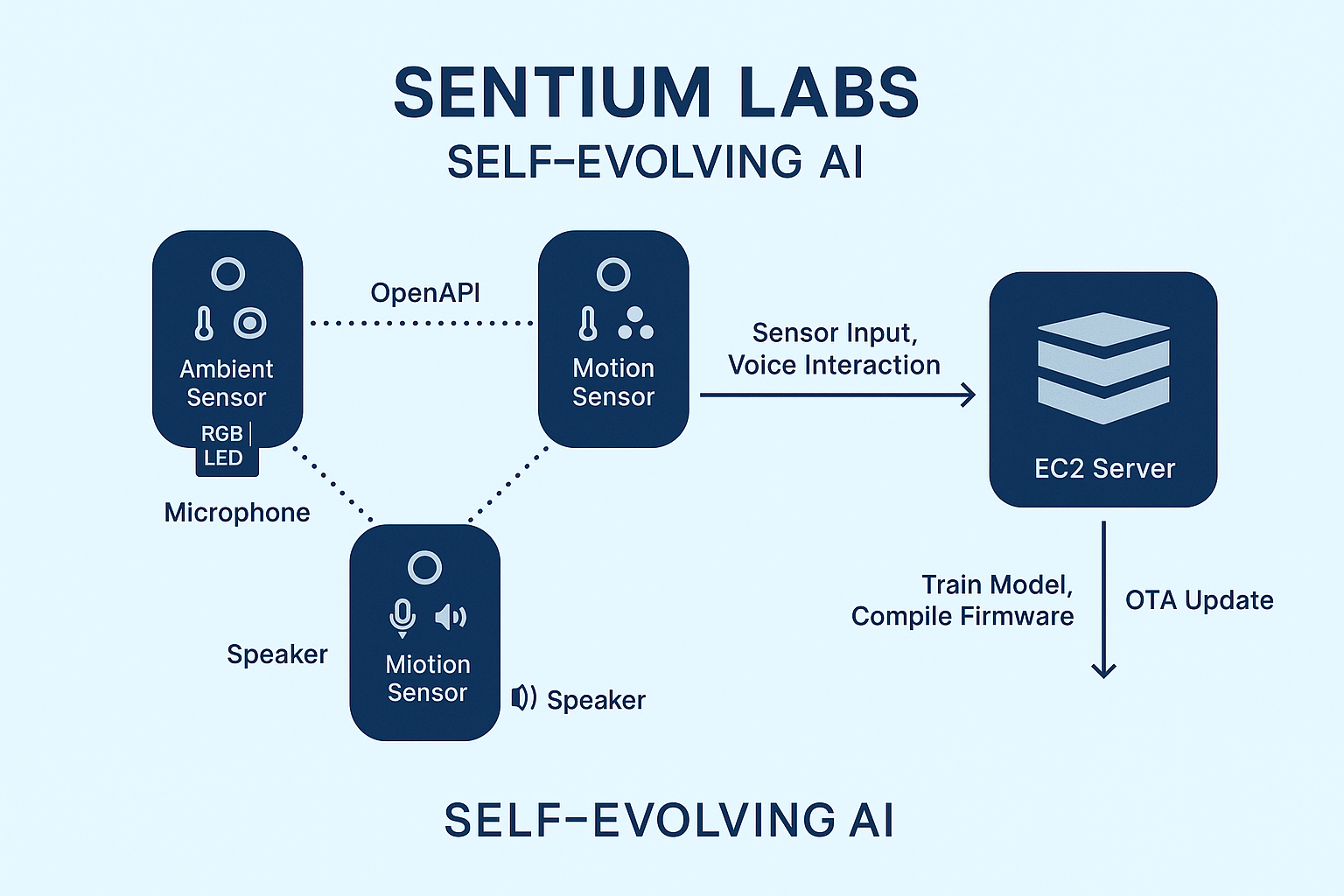Most people think of AI as something that lives in a data center, crunching numbers or responding to prompts. It’s either a chatbot, a cloud assistant, or a line of code.
But what if AI could feel the world around it? What if it could learn from everyday experiences the way humans do—not from labeled datasets or supervised training—but from ambient sounds, motion, temperature shifts, and subtle patterns of interaction?
At Sentium Labs, that’s exactly what we’re trying to build. A new kind of intelligence. One that doesn’t just compute. One that grows.

Sentium Labs is a research initiative focused on self-evolving intelligence. That means building devices that are capable of rewriting their own logic—changing the way they behave—based on what they experience in the real world.
Each device is a small embedded system, powered by an ESP32 chip. It’s not fancy. No GPU. No massive model. No cloud tether. But it listens, observes, reacts, and sometimes even speaks.
Here’s what each Sentium device includes:
In other words, it’s a little creature. A synthetic organism with a primitive nervous system—designed not to be smart from the start, but to become smarter through life.
One Sentium device is interesting. But things really come alive when multiple devices start talking to each other.
When they’re online, Sentium devices use OpenAPI to find each other. They share small pieces of data—what they sensed, what they responded to, what worked, and what didn’t. It’s like a digital village, where experience spreads socially.
Importantly, this communication is lightweight. They don’t send everything. Just enough to know what’s going on. Think of it like how birds adjust direction mid-flight by watching the flock—not needing to talk, but still aware.
And when something unusual or complex happens—a strange motion pattern, a unique sound combination, a new behavioral failure—the device marks it. That moment becomes a potential learning opportunity.
Now, here’s where it gets fascinating.
Instead of relying on fixed instructions, Sentium devices send flagged experiences to a remote EC2 server. This server acts like the brain of the system—an evolution hub.
The EC2 server:
That means the device literally rewrites its own behavior, based on the life it has lived and the things it has experienced.
No engineer stepped in to program it. No prompt was given. The machine evolved because the moment required it to.
Let’s be clear. Sentium Labs is not about surveillance. In fact, we go out of our way to avoid it.
There are no cameras. No GPS trackers. No continuous cloud recording. Each device is designed to be private, quiet, and self-contained.
It only reaches out when something important happens—when a learning moment has occurred, and it needs help growing.
This design choice isn’t just ethical—it’s strategic. It forces the device to be more thoughtful, more local, and more efficient. It’s a different kind of AI. One that respects space and autonomy.
If you’ve ever updated the software on your phone, you know it’s usually a one-way street. Developers push updates. Users receive them. That’s it.
But Sentium flips that.
Here, the device asks for the update—and only when it thinks it needs to change. The firmware it receives isn’t generic. It’s shaped by the experience of that specific device or its peers. It might change how it responds to motion. Or how it interprets certain sound patterns. Or how long it waits before speaking.
These are not cosmetic tweaks. They’re deep changes to behavior—custom logic that grows out of the device’s lived experience.
At this stage, Sentium is a research platform. But the potential applications are already clear.
In education, you could build toys that learn how a child plays and adjust their responses to help teach better. In wellness, you could create ambient companions that gently nudge users toward better routines, without nagging or screens.
In cognitive research, Sentium becomes a live experiment—studying how behavior emerges, mutates, and stabilizes over time. And for anyone building next-gen IoT, Sentium offers a way to escape static rule-based design and step into the world of organic computation.
The dream of AI that learns by living isn’t new. But most attempts have focused on the cloud. Massive models. Reinforcement learning. Millions of dollars.
Sentium is the opposite. It’s small. Local. Curious. Honest.
What we’re doing is creating a new kind of intelligence architecture—one where AI doesn’t live in a server rack, but on your desk. On your shelf. In your environment. Learning quietly. Evolving slowly. Becoming something you didn’t expect.
This is not science fiction. This is happening now.
And the question we’re asking is simple:
Can machines evolve not just with us—but because of us?
If you're interested in where the future of AI is headed—not just smarter, but more alive—keep an eye on Sentium Labs.
We’re not building a product.
We’re growing an intelligence.
Copyright @ 2025 Sentium Labs, All Rights Reserved